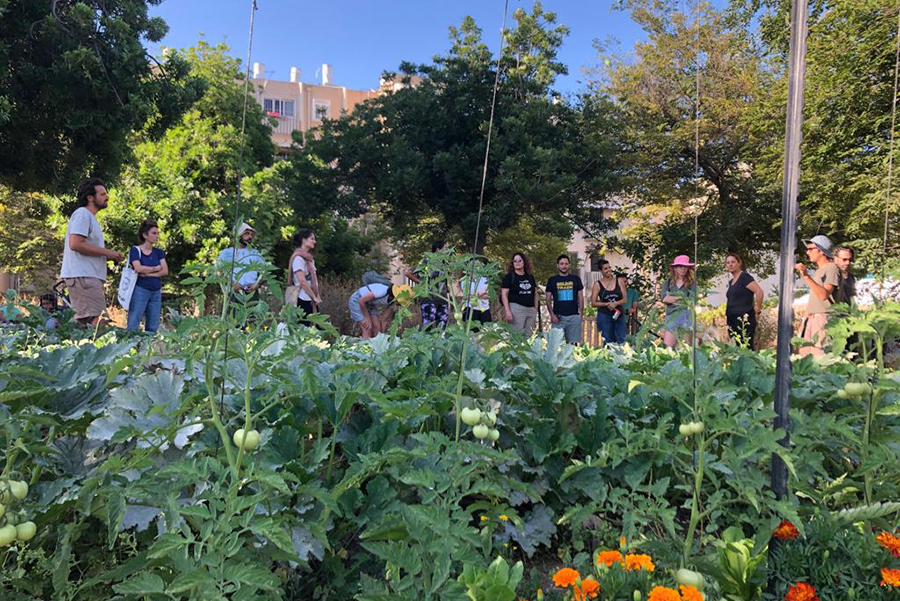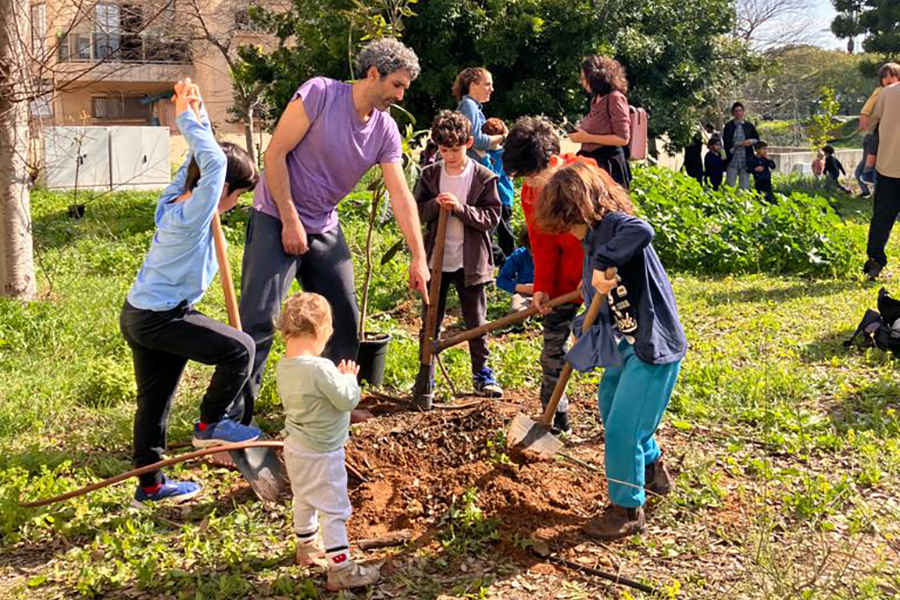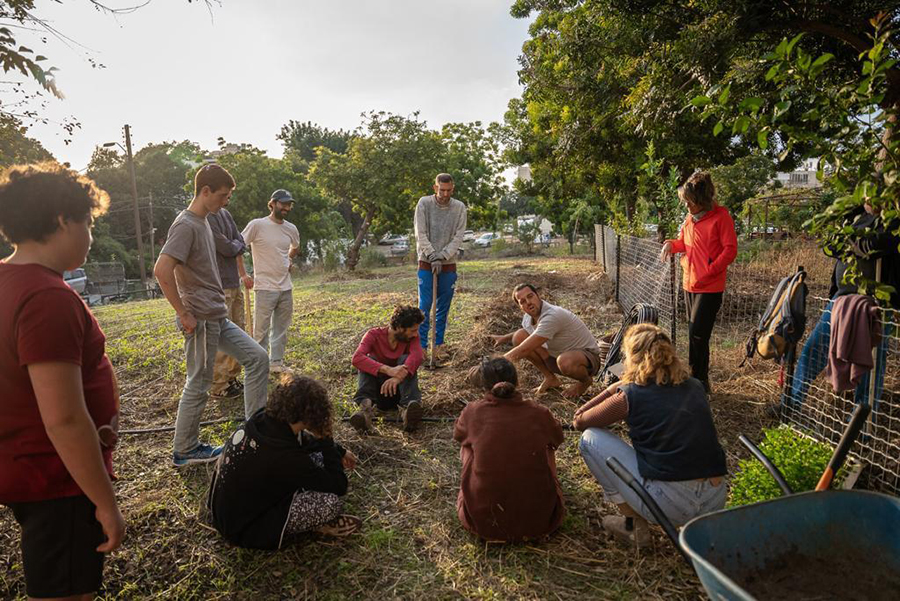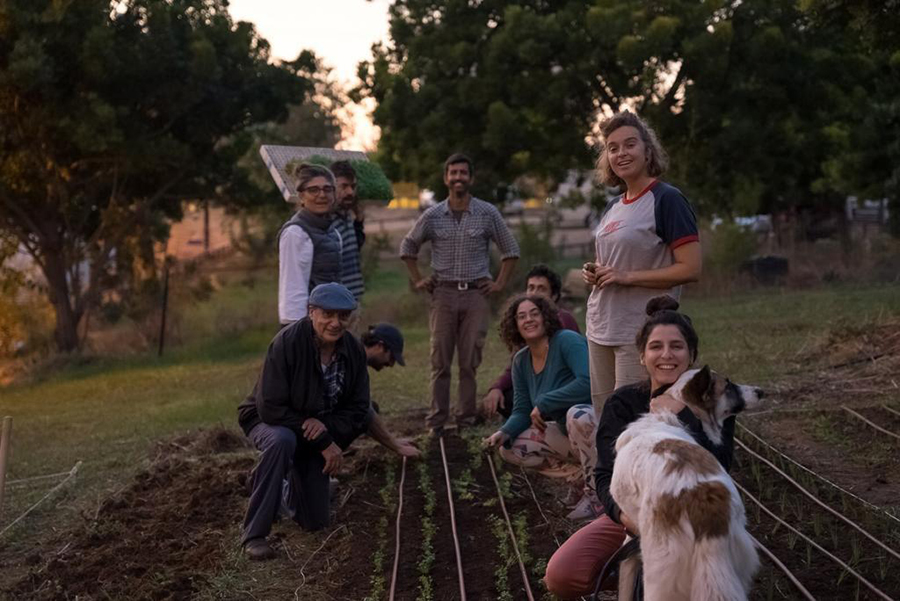Benefits of Urban Greening
Harnessing the Power of Plants
Planning and designing urban public spaces with nature in mind is a key aspect of the City adaptation plan. Not only does it increase biodiversity and improve the local ecosystem, but it also contributes to local sustainability and community resilience. Tel Aviv-Yafo is committed to developing urban nature and protecting it. Tel Chubez is one of many other urban nature sites that create the City’s green belt.
Delivering Multiple Benefits
For over a decade, the City of Tel Aviv-Yafo has been promoting the Sustainable Neighbourhoods programme. Within this programme, the sustainability coordinator connects with residents and works together to advance environmental initiatives to improve the quality of life in public spaces and adopt sustainable lifestyles. What started as a grassroots initiative has become an integral part of the Sustainable Neighbourhoods programme in Shapira. Municipal support for this initiative includes employing staff members and the neighbourhood sustainability coordinator being part of the association’s management team. City units also support the maintenance of the composting network and local food programmes. Beyond its physical presence as a farm, Tel Chubez also serves as a meeting place for various urban sustainability programmes. The City views Tel Chubez and the Lira Shapira model as a replicable model for other neighbourhoods in the City that can be scaled up and increase the positive impact.
The City’s Bold and Innovative Vision
Tel Chubez’s programme embodies a bold vision for urban living by championing the principles of the circular economy and empowering local communities to take control of their organic waste and food production. It challenges conventional perspectives on waste, agriculture and urban development. Encouraging residents to see waste as a resource, urban nature as part of their lives, and consumption habits as opportunities for mindful choices.
This visionary approach not only fosters resilient communities but also serves as an educational hub, promoting sustainable living practices. Tel Chubez’s success highlights its significance in inspiring other city neighbourhoods dealing with similar challenges.
Tel Chubez’s programme is based on circular economy principles where the local community takes responsibility for their organic waste and turns waste hazards in to a resource for growing food, community and local economy. The project combines best practices from various fields while breaking the traditional perspectives people have on food and where it comes from, how urban nature can look, and ways they can purchase goods.
Partnerships and Collaboration
Tel Chubez is an outstanding example of collaboration across sectors. What started as a small initiative by a few activists became a great experience working with various city units, including the Environmental and Sustainability Authority, the City Architect office, the Education Department, the Shefa and sanitation division, and many more. It is also a collaboration between the City and nonprofit organisations, local businesses, and individuals who contribute their knowledge and skills to promote the plan and expand it dramatically.
A productive green space in flexible and inclusive neighbourhoods allows new stakeholders to integrate. Only in the last year, two new health plans were added dealing with food waste and healthy nutrition, the farm took place in the Open Houses city event for architecture, and more businesses joined the poll of Lira Shapira.
Addressing Urban Challenges
The Issue
Shapira Neighbourhood, located in the southeast region of Tel Aviv-Yafo, is an underserved area facing challenges from various aspects. Socioeconomic gaps, higher vulnerability to climate change, massive infrastructure projects that are changing the face of the place, and lack of green spaces are a few of those challenges.
Tel Chubez provides the local population with the opportunity to reclaim ownership of their changing environment. It is a green, beautiful place to walk to and connect with neighbours, be physically active and work the land, and purchase healthy vegetables with local currency they can easily earn. The activities at the farm are open to all ages all day long, and the connections between the people support the community’s resilience to address challenges together.
Without this anchor in the neighbourhood, many small initiatives would not find a place; it became a home not just for ‘nature lovers’ but also for the wider population that is looking for comfort and support.
The Impact of the Issue
Food insecurity, disconnection from nature, lack of physical activity, and increased waste production due to excessive consumption are all part of the modern world’s challenges. The negative environmental impacts of such a lifestyle are significant and broadly influence health, social connections and long-term sustainability; it affects the quality of life and wellbeing of all residents.
A Nature Orientated Future
Tel Chubez addresses these modern challenges holistically. It connects those problems and presents them circularly, allowing people to join them from various perspectives.
Purchasing products with a local currency earned through organic waste disposal is not just an economic concept but a transformative practice encompassing several fundamental societal values.
It emphasises buying fresh, organic and locally sourced vegetables, selling without packaging or transportation. Moreover, the created platform increased the internal collaboration within the neighbourhood, including diverse, vulnerable communities. Tel Chubez represents a holistic shift towards more mindful and ecologically conscious living, highlighting the interplay between economic choices, nutrition, and community engagement in building a sustainable and healthier future.
Nature Positive Solutions
Implementation
The implementation of the initiative, as described, has been a dynamic and collaborative effort since 2018 and driven by a diverse range of partners and stakeholders. The primary objective is to achieve a nature-positive outcome for the City, addressing multiple challenges while demonstrating tangible progress.
This initiative has addressed the City’s challenges described before and showcased remarkable progress in the short term.
The quantitative metrics indicate that the project is experiencing sustained exponential growth, and the unique connection established with the residents is exceptional. Fostering a nature-positive outcome, the initiative contributes to a more resilient and sustainable urban environment, positioning itself as a model for future urban planning and development.
Feasibility
As it becomes a city project, all units add expenses to their annual budget.
Multi-Stakeholder Support
The project involves numerous partners and stakeholders who are pivotal to its success. These include:
- Lira Shapira nonprofit: This association is a critical player in the project, responsible for managing the local currency system and its associated benefits and incentives.
- Municipal Units:
- Environmental and Sustainability Authority: This department oversees environmental quality and sustainability initiatives, ensuring the project aligns with the City’s ecological and community goals. This division includes the sustainability coordinator, the urban agriculture manager and the compost network coordinator. Training and courses are developed with the team.
- City Architect: The City’s architect is involved in urban planning, ensuring the project integrates seamlessly into the City’s landscape and infrastructure.
- Operation Department (Shefa): Responsible for identifying locations for urban composting network, trimming and tree planting.
- Water Conservation and Management Department: Focuses on water conservation efforts and managing water resources, including runoff.
- Community Services: The project encompasses community services, such as neighbourhood-based services facilitated through a community centre.
- Local Businesses: Fifteen local businesses are part of the project, including small restaurants and individuals working independently from home. These businesses participate in the local currency system, supporting the initiative by accepting Lira Shapira or goods and services.
The collaboration among these diverse partners creates a dynamic ecosystem focused on sustainability, waste reduction and community empowerment. Together, they contribute to the project’s success and its positive impact on the local economy, environment and quality of life for residents.
Management and Maintenance
Urban process facilitation through extensive collaboration is something that the Tel Aviv municipality recognises and excels in. The project is part of a broader initiative called Sustainable Neighbourhoods, which is funded by municipal resources and closely supervised by the Deputy CEO. Regular meetings are held with partners throughout the year, and through discussions, training, and personal connections, on-the-ground issues are addressed effectively. The municipal commitment to promoting sustainability, climate change adaptation, and strengthening vulnerable populations is integral to annual work plans and is well-integrated into all urban units.
Measuring and Reporting Impact
Monitoring Results
Comprehensive data collection mechanisms are established to monitor various quantitative and qualitative indicators. These include metrics such as the quantity of organic waste collected, the number of participants in training sessions, the amount of produce sold, and community feedback regarding satisfaction and engagement. Data is systematically analysed to track trends and progress over time.
We are still missing monitoring and measures to evaluate the initiative’s impact. Enhancing biodiversity, reducing GHG emissions, reducing food miles and fostering community wellbeing are some of the indicators we would like to further explore.
Demonstrating Progress
Tel Chubez is one of several projects within the umbrella of urban agriculture falling under the purview of Urban Nature. Currently, the municipality is promoting an Urban Nature survey to update the urban nature sites for the evolving master plan. The new plan adopts a broader perspective on urban nature, combining ecological and community considerations. Alongside this, a detailed plan is being developed to create an urban ecological corridor that connects these nature and urban agriculture sites to connect it all to one continuous green belt. The benefits of integrating nature into the City are well-recognised by stakeholders, as is the value of community and educational activities surrounding these sites. We believe that aligning the updated master plan with this new perspective can position the Tel Chubez project as part of a local urban nature network, potentially enhancing its capacity to secure additional funding.
Measuring Impact
Tel Chubez’s programme includes a combination of quantitative and qualitative indicators.
Quantitative data is collected for the number of training sessions on subjects related to health, nutrition, urban agriculture, and sustainable lifestyles and the number of participants in each training session. Data is also gathered on the quantity of organic waste delivered by participants in kilograms, the number of Shapira Shekels (local currency) produced throughout the year, the number of active businesses within the programme, and the quantity of produce sold at the weekly market from the farm. These quantitative indicators are continuously evolving.
Additionally, qualitative indicators assess the diversity of the participating population, the satisfaction levels of participants with the programme, and other elements derived from the personal interaction between the sustainability coordinator and neighbourhood residents.
Overall, there is an ongoing effort to improve the programme’s assessment and measurement indicators, aligning with urban sustainability goals and the Climate Action Plan.
Learning and Transferability
Adaption and Enhancement
One of the beautiful aspects of the programme is its flexibility and the ability to make local adaptations when needed. The partners come from various ideologies and are willing to compromise. The constant presence of nonprofit members and the urban coordinators’ team enables positive communication among urban units, and the discovery of creative and swift solutions within the sometimes complex and sluggish urban system.
Potential for Replication
The successful cultivation of vegetables in the City and the establishment of a pesticide-free farm serve as a reinforcement for urban initiatives that have previously begun around sustainable gardening practices, the use of local flora and the revitalisation of urban aesthetics. The place also hosts workshops, including those led by professionals, to spread this approach to other locations in the city.
Inspiring Other Cities
Urban agriculture as part of the urban nature concept and integrating nature into the City is a topic that engages many cities. Naturally, Tel Aviv is perceived as a leading and innovative City, and successful practices established here are shared with other cities through various collaborative platforms. These practices spread from the 15th Forum to government-led task forces and peer learning.
Tel Chubez’s programme, as part of Sustainable Neighbourhoods and Urban Nature, is also reported through the C40 accelerator for Urban Nature. The City is committed to and linked to a metropolitan urban nature declaration signed by 12 municipalities constituting Israel’s most densely populated metro area.
Resilience
Reducing Negative Impacts and Ensuring Sustainability
As outlined in the programme, the primary method of driving the local economy revolves around the separation and management of household organic waste. Organic waste, characterised by a high carbon footprint, is diverted from landfills and instead transformed into compost, significantly contributing to the City’s reduction of greenhouse gas emissions.
According to the carbon emission inventory, over 40% of urban emissions in the waste sector stem from the disposal of food remnants and untreated trim and wood waste. The neighbourhood composting network effectively addresses this issue.
Additionally, local food cultivation and direct sales reduce the need for packaging, transportation and food wastage, contributing to greenhouse gas emissions. The cyclical approach of the programme, combined with its extensive network of partners, ensures long-term sustainability and the creation of positive feedback loops.
Environmental Considerations
On the farm, vegetables are grown without pesticides or synthetic fertilisers, following seasonal patterns. The farming methods employed are traditional, emphasising minimal intervention, and deep consideration for biological diversity and the ecological system. Composting is a crucial component, enriching the soil, improving water retention and reducing waste. The farm employs soil mulching to preserve soil moisture, and irrigation is done through an efficient drip system, ensuring water conservation.
Use of Natural Resources
Once a year, wildflower seeds are planted to enrich the ecosystem and stabilise it. These flowers attract pollinators like bees and butterflies. Rainwater is collected in barrels for vegetable washing and handwashing. The farm operates with minimal use of natural resources, continually strengthening its sustainable practices.
























